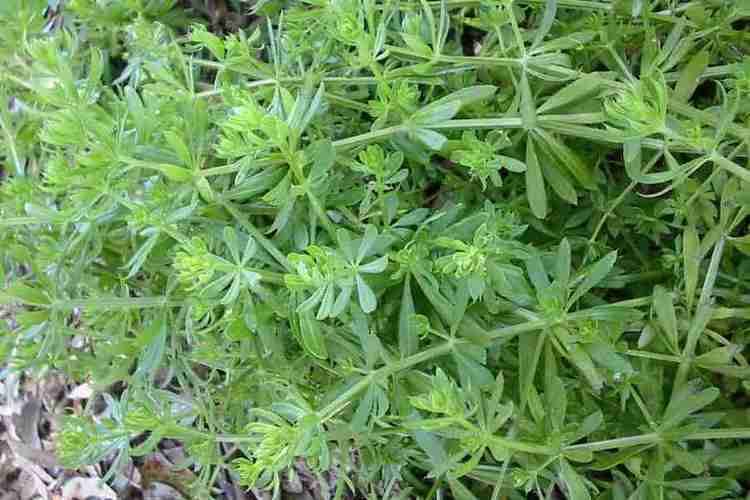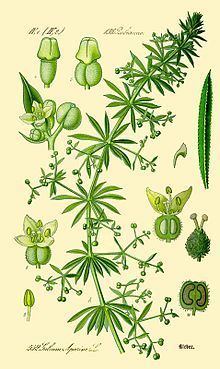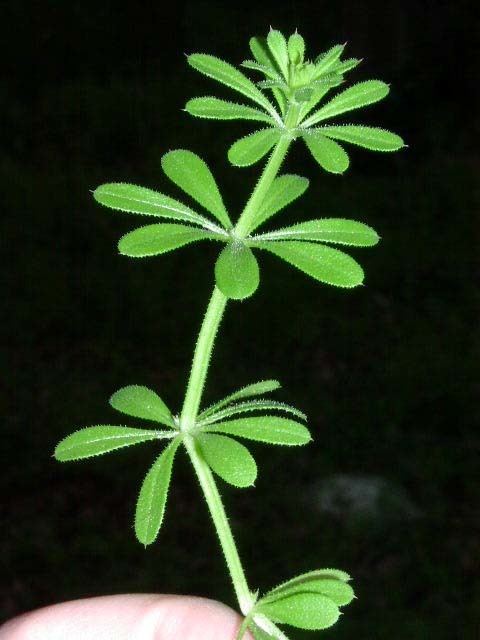Rank Species | Genus Galium Higher classification Galium | |
 | ||
Similar Common Chickenweed, Lamb's Quarters, Shepherd's Purse, Creeping Thistle, Black Bindweed | ||
Edible plants cleavers galium aparine
Galium aparine, ('aparine' from Greek 'apairo' - “lay hold of” or “seize”) with many common names including cleavers, clivers, goosegrass, catchweed, stickyweed, robin-run-the-hedge, sticky willy, sticky willow, stickyjack, stickeljack, and grip grass, is a herbaceous annual plant of the family Rubiaceae.
Contents
- Edible plants cleavers galium aparine
- Cleavers galium aparine stickywilly 2012 06 23
- Description
- Distribution
- Effects on the body
- Chemistry
- Edibility
- Folk medicine
- Other uses
- Ecology
- References

Cleavers galium aparine stickywilly 2012 06 23
Description
Cleavers are annuals with creeping straggling stems which branch and grow along the ground and over other plants. They attach themselves with the small hooked hairs which grow out of the stems and leaves. The stems can reach up to three feet or longer, and are angular or square shaped. The leaves are simple, narrowly oblanceolate to linear, and borne in whorls of six to eight.

Cleavers have tiny, star-shaped, white to greenish flowers, which emerge from early spring to summer. The flowers are clustered in groups of two or three, and are borne out of the leaf axils. The globular fruits are burrs which grow one to three seeds clustered together; they are covered with hooked hairs which cling to animal fur, aiding in seed dispersal.
Distribution

The species is native to a wide region of Europe, North Africa and Asia from Britain and the Canary Islands to Japan. It is now naturalized throughout most of the United States, Canada, Mexico, Central America, South America, Australia, New Zealand, some oceanic islands and scattered locations in Africa. Whether it is native to North America is a question of some debate, but it is considered to be native there in most literature. It is considered a noxious weed in many places.
Effects on the body
For some people, skin contact with Galium aparine causes an unpleasant localized rash known as contact dermatitis.
Chemistry

Chemical constituents of Galium aparine include: iridoid glycosides such as asperulosidic acid and 10-deacetylasperulosidic acid, asperuloside, monotropein and aucubin, alkaloids such as caffeine, phenolics such as phenolic acids, anthraquinone derivatives such as the aldehyde nordamnacanthal (1,3-dihydroxy-anthraquinone-2-al), flavonoids and coumarins, organic acids such as citric acid and a red dye.
Edibility
Galium aparine is edible. The leaves and stems of the plant can be cooked as a leaf vegetable if gathered before the fruits appear. However, the numerous small hooks which cover the plant and give it its clinging nature can make it less palatable if eaten raw. Geese thoroughly enjoy eating G. aparine, hence one of its other common names, "goosegrass". Cleavers are in the same family as coffee. The fruits of cleavers have often been dried and roasted, and then used as a coffee substitute which contains less caffeine.
Folk medicine
Poultices and washes made from cleavers were traditionally used to treat a variety of skin ailments, light wounds and burns. As a pulp, it has been used to relieve poisonous bites and stings. To make a poultice, the entire plant is used, and applied directly to the affected area.
Other uses
Dioscorides reported that ancient Greek shepherds would use the barbed stems of cleavers to make a "rough sieve", which could be used to strain milk. Linnaeus later reported the same usage in Sweden, a tradition that is still practiced in modern times.
In Europe, the dried, matted foliage of the plant was once used to stuff mattresses. Several of the bedstraws were used for this purpose because the clinging hairs cause the branches to stick together, which enables the mattress filling to maintain a uniform thickness. The roots of cleavers can be used to make a permanent red dye.
Ecology
The plant can be found growing in hedges and waste places, limestone scree and as a garden weed.
G. aparine prefers moist soils and can exist in areas with poor drainage. It reportedly flourishes in heavy soils with above-average nitroen and phosphorus content, and prefers soils with a pH value between 5.5 and 8.0. G. aparine is often found in postfire plant communities in the United States, likely developing from onsite seed and therefore rendering controlled burns as an ineffective means of removing G. aparine in areas where it is considered a noxious weed.
The anthraquinone aldehyde nordamnacanthal (1,3-dihydroxy-anthraquinone-2-al) present in G. aparine has an antifeedant activity against Spodoptera litura, the Oriental leafworm moth, a species which is considered an agricultural pest. The Acari Cecidophyes rouhollahi can be found on G. aparine.
